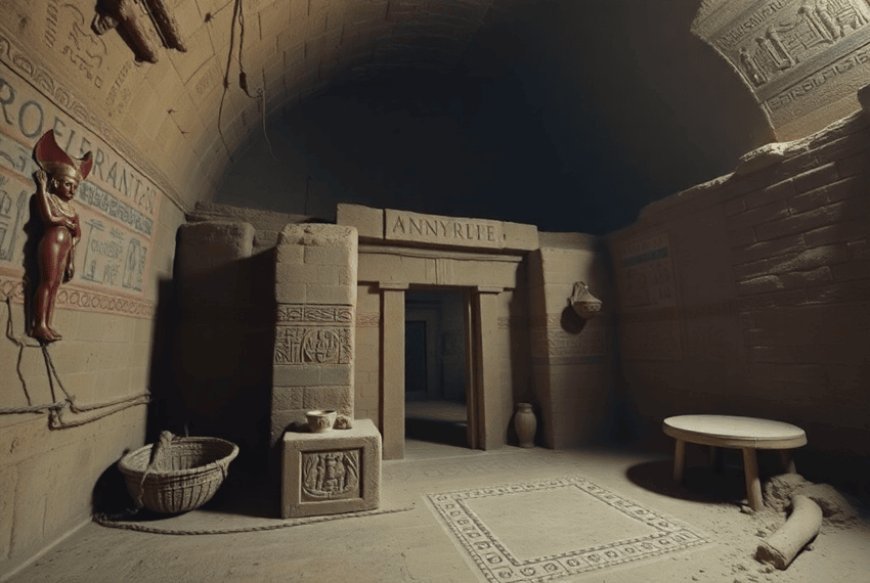Unearthed in Egypt: Is This 3,200-Year-Old Tomb Hiding Secrets That Could Rewrite History?


For those with an insatiable curiosity about ancient Egypt, a newly uncovered tomb in northeastern Egypt offers an exciting glimpse into the country’s rich past. The discovery of a 3,200-year-old tomb, thought to belong to a military commander from the era of Ramesses III, is set to make waves in the world of archaeology and travel. Located at the Tell el-Maschuta site, this tomb opens a new chapter in Egypt’s long history, offering travelers and history buffs alike a unique opportunity to connect with ancient Egyptian culture and history.
As Egypt continues to unearth ancient relics, this discovery enhances the country’s reputation as a prime destination for cultural tourism, making it a must-visit for those interested in history, archaeology, and the treasures of ancient civilizations. The tomb is expected to become a major attraction for travelers, further solidifying Egypt’s place on the global tourist map.
Uncovering a Lost Chapter of Egyptian History
The tomb, which dates back to the time of Ramesses III (1184–1153 B.C.), provides a tangible connection to a time of military power and political intrigue. Archaeologists believe the tomb once belonged to a high-ranking military officer from the pharaoh’s era. The structure of the tomb itself is fascinating—built from mud bricks, it consists of a main burial chamber and three additional rooms. This layout suggests that the tomb was not just a resting place, but a space carefully designed to honor the individual’s status and role in society.
Inside, significant artifacts were discovered, further bolstering the importance of the site. Among the most remarkable finds is a gold ring inscribed with the name of Ramesses III. This detail highlights the connection between the tomb’s occupant and the royal family, offering invaluable insights into the interactions between Egypt’s military leaders and its pharaohs. Additionally, the tomb contains a collection of bronze arrowheads, further emphasizing the military significance of the person buried there. These items, combined with the discovery of intricately carved ivory boxes and pottery vessels, tell a story of a warrior and a high-ranking figure in ancient Egyptian society.
Artifacts with Intriguing Historical Significance
The discovery of the tomb has provided a wealth of artifacts that speak volumes about the past. Among the most intriguing pieces is the gold ring, bearing the name of Ramesses III, which has captured the attention of historians and archaeologists alike. The presence of this artifact suggests a direct link between the military commander buried in the tomb and the pharaoh, who ruled Egypt during the late 12th century BC.
Other items found in the tomb, such as the bronze arrowheads, provide further clues about the occupant’s role in Egypt’s military. These weapons were likely used by the tomb’s owner during campaigns or battles, painting a picture of the man as a warrior who held a significant place in the royal court. The presence of an ivory box and pottery vessels with inscriptions adds another layer of complexity to the find. The inscriptions on the pottery, in particular, have sparked considerable interest, as they reference Horemheb, a military leader who would later become the pharaoh of Egypt.
A Link to Horemheb: A Glimpse into Egypt’s Military Legacy
The discovery of pottery inscriptions that reference Horemheb, a pharaoh who reigned from 1323 to 1295 B.C., has raised important questions about the tomb’s history. Known for his military prowess before ascending the throne, Horemheb’s name appears on several items found within the tomb. This could suggest that the tomb’s occupant had some connection to Horemheb’s reign or that burial items from an earlier period were repurposed for the tomb’s construction.
While this theory remains speculative, it adds another layer of intrigue to the tomb’s story. Some archaeologists believe that the tomb may have been constructed during Horemheb’s reign and later repurposed during the time of Ramesses III. This would imply that the tomb went through multiple phases, possibly reflecting the shifting political landscape of ancient Egypt.
The Role of Ramesses III and the Military Elite
The tomb’s connection to Ramesses III, however, remains central to its significance. The reign of Ramesses III was marked by military campaigns and attempts to protect Egypt from external threats. The discovery of this tomb offers a fascinating insight into the military elite of the time and their interactions with the pharaoh. It also provides a unique opportunity to explore the relationship between power, warfare, and burial practices in ancient Egypt.
As the tomb was used during Ramesses III’s reign, the artifacts and inscriptions found inside offer a window into the world of Egypt’s military leaders. These were not just men of power but also men of influence, entrusted with the defense of the kingdom. The tomb serves as a reminder of the complex, multifaceted nature of ancient Egyptian society, where military, political, and religious roles often intersected.
Tourism and the Potential of New Archaeological Sites
For travelers, the discovery of this tomb represents more than just a fascinating historical find; it marks the opening of a new chapter in Egypt’s already rich archaeological landscape. Egypt has long been a destination for those seeking to connect with ancient history, and this new discovery will only enhance its appeal as a cultural and archaeological hub. The Tell el-Maschuta site, with its newly unearthed tomb, is likely to become a focal point for those interested in ancient Egypt’s military history, offering tourists a chance to explore a relatively lesser-known but significant part of Egyptian heritage.
In the broader context of the tourism industry, this discovery highlights the growing interest in lesser-known archaeological sites. While Egypt’s iconic attractions like the Pyramids of Giza and the Valley of the Kings continue to draw massive crowds, new discoveries like this one offer a fresh perspective on the country’s ancient past. These discoveries provide both seasoned travelers and new visitors with a deeper understanding of Egypt’s history and culture.
The Global Impact: A Shift Toward Sustainable, Culturally Rich Tourism
As more and more archaeological sites are uncovered, the global travel industry may see a shift toward a more sustainable, culturally rich form of tourism. Tourists increasingly seek meaningful experiences that allow them to connect with history and culture. This discovery in northeastern Egypt is a prime example of how the tourism industry can benefit from the ongoing uncovering of ancient artifacts. Not only does it enrich the visitor experience, but it also emphasizes the need to preserve these sites for future generations.
Furthermore, the increased interest in Egypt’s lesser-known sites may lead to more sustainable tourism practices. With a growing number of travelers flocking to explore Egypt’s rich history, there will be a stronger emphasis on conservation and responsible travel. Tour operators and government bodies are likely to increase efforts to promote sustainable tourism, ensuring that new discoveries like the Tell el-Maschuta tomb are protected while still being accessible to the public.
Future Excavations: What Lies Ahead?
While the recent discovery of the tomb in northeastern Egypt is already making waves in the archaeological community, experts believe that there is still much more to be uncovered at the site. Continued excavations could reveal additional tombs, artifacts, and inscriptions that further illuminate the lives of those who lived during the time of Ramesses III and earlier periods.
For travelers, this means that future visits to the Tell el-Maschuta site could offer even more opportunities to explore Egypt’s ancient history. As the site continues to be studied, it could become a key destination for those seeking a deeper understanding of Egypt’s military and political past.
A Rich Discovery That Shines a Light on Egypt’s Past
The unearthing of this 3,200-year-old tomb in northeastern Egypt is a landmark discovery that adds another layer to the fascinating history of one of the world’s oldest civilizations. With its remarkable artifacts and potential connections to key historical figures like Horemheb and Ramesses III, the tomb offers a window into the past, enriching both the archaeological field and the global tourism industry. For travelers seeking a unique and culturally enriching experience, Egypt continues to deliver, offering an ever-expanding tapestry of ancient wonders to explore.
The post Unearthed in Egypt: Is This 3,200-Year-Old Tomb Hiding Secrets That Could Rewrite History? appeared first on Travel And Tour World.
What's Your Reaction?
 Like
0
Like
0
 Dislike
0
Dislike
0
 Love
0
Love
0
 Funny
0
Funny
0
 Angry
0
Angry
0
 Sad
0
Sad
0
 Wow
0
Wow
0














































